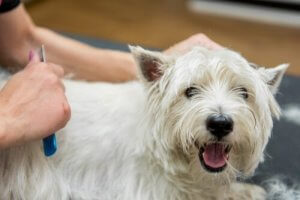Caring for Your Dog's Coat in Summer


Written and verified by the lawyer Francisco María García
Caring for your dog’s coat in summer is essential, allowing you to safely enjoy the warm weather together. Generally speaking, the care your dog requires will largely depend on the length of its coat, as well as factors such as breed.
For many owners, the arrival of summer is the perfect opportunity to enjoy some quality time with their pets. Blue skies and warmer weather mean that dog walkers usually start to venture further afield, finding new and exciting places to take their four-legged friends.
But without prior planning, these long summer walks can actually be dangerous for your pet. If you really want to enjoy summer to the full, you need to take the time to organize your trips properly, and ensure your pet is summer-ready.
Why is caring for your dog’s coat so important?
During the summer, the sun’s rays get stronger, and temperatures rise. For both dogs and humans, skincare and haircare become even more important.

It’s important to remember that a dog’s cooling system is more complex than a human’s. Their bodies are more sensitive to the heat, with thermoregulatory mechanisms kicking in from as low as 68°F.
Humans have sweat glands all over their bodies. These are activated as soon as the body detects a significant rise in temperature, releasing water which then evaporates from the skin’s surface. So, when exercising or out in the hot sun, humans sweat more to help the body stay cool.
Dogs sweat through their paws
Dogs, however, only possess sweat glands on the pads of their paws, meaning they only sweat through their feet. They also use their tongues to help them keep cool, as panting allows the moisture in their mouths to evaporate.
Moreover, dogs are well-accustomed to being directly exposed to the sun’s rays. They don’t wear clothes or other accessories, and generally enjoy being outside in the sunshine.
Their main source of protection against changes in weather conditions is their fur. In cold weather, fur acts as insulation, reducing heat loss. During the summer, fur shades the skin from the sun, preventing direct exposure to the sun’s rays. As such, taking care of your dog’s coat is essential for their health and well-being, regardless of the time of year.
How to take care of your dog’s coat in summer
The most important thing is to make sure your dog stays healthy. Regular trips to the vet are essential. You’ll also need to ensure their vaccinations are up to date, and make sure to treat them for parasites.
Our top tips
1. Protect their skin and fur from the sun. Excessive exposure to the sun’s UV rays is harmful to both animals and humans.
2. Just like humans, dogs can suffer from sunburn, heat rash and skin cancer. As such, it’s important to take good care of their skin and coat during the summer.
3. Stay hydrated. The body loses a lot of water when exposed to high temperatures, so it’s important for your pet to drink plenty of water in hot weather. On average, experts recommend that the average person should drink eight 8-ounce glasses of water per day. In summer, this should be doubled. The same goes for our four-legged friends.
4. Good ventilation (natural or artificial). A dog’s skin needs to be able to exchange fluids with the environment to stay healthy. As such, it’s important to provide good ventilation, and plenty of shade from the sun.
Consult with a vet if you notice symptoms such as skin irritations, bites or red, inflamed skin. Avoid risk factors as far as possible, and keep their environment clean. You may also want to consider switching them to a hypoallergenic diet.

Some final pieces of advice:
1. Allergies: the heat and humidity of the summer tend to increase the risk of allergies and dermatitis, especially in dogs that are overweight, or already suffer from allergies.
2. Time for a hair cut: many animals have fur that is specifically designed to act as insulation. This is especially true of dogs originating from cold regions. One of the best ways you can take care of your pet in summer is to take them to a groomer for a hair cut.
3. Regular brushing: a dog’s coat usually changes depending on the time of year. This normally involves molting, especially during the summer. Brushing them at least once a week will help remove any loose hair.
Caring for your dog’s coat in summer is essential, allowing you to safely enjoy the warm weather together. Generally speaking, the care your dog requires will largely depend on the length of its coat, as well as factors such as breed.
For many owners, the arrival of summer is the perfect opportunity to enjoy some quality time with their pets. Blue skies and warmer weather mean that dog walkers usually start to venture further afield, finding new and exciting places to take their four-legged friends.
But without prior planning, these long summer walks can actually be dangerous for your pet. If you really want to enjoy summer to the full, you need to take the time to organize your trips properly, and ensure your pet is summer-ready.
Why is caring for your dog’s coat so important?
During the summer, the sun’s rays get stronger, and temperatures rise. For both dogs and humans, skincare and haircare become even more important.

It’s important to remember that a dog’s cooling system is more complex than a human’s. Their bodies are more sensitive to the heat, with thermoregulatory mechanisms kicking in from as low as 68°F.
Humans have sweat glands all over their bodies. These are activated as soon as the body detects a significant rise in temperature, releasing water which then evaporates from the skin’s surface. So, when exercising or out in the hot sun, humans sweat more to help the body stay cool.
Dogs sweat through their paws
Dogs, however, only possess sweat glands on the pads of their paws, meaning they only sweat through their feet. They also use their tongues to help them keep cool, as panting allows the moisture in their mouths to evaporate.
Moreover, dogs are well-accustomed to being directly exposed to the sun’s rays. They don’t wear clothes or other accessories, and generally enjoy being outside in the sunshine.
Their main source of protection against changes in weather conditions is their fur. In cold weather, fur acts as insulation, reducing heat loss. During the summer, fur shades the skin from the sun, preventing direct exposure to the sun’s rays. As such, taking care of your dog’s coat is essential for their health and well-being, regardless of the time of year.
How to take care of your dog’s coat in summer
The most important thing is to make sure your dog stays healthy. Regular trips to the vet are essential. You’ll also need to ensure their vaccinations are up to date, and make sure to treat them for parasites.
Our top tips
1. Protect their skin and fur from the sun. Excessive exposure to the sun’s UV rays is harmful to both animals and humans.
2. Just like humans, dogs can suffer from sunburn, heat rash and skin cancer. As such, it’s important to take good care of their skin and coat during the summer.
3. Stay hydrated. The body loses a lot of water when exposed to high temperatures, so it’s important for your pet to drink plenty of water in hot weather. On average, experts recommend that the average person should drink eight 8-ounce glasses of water per day. In summer, this should be doubled. The same goes for our four-legged friends.
4. Good ventilation (natural or artificial). A dog’s skin needs to be able to exchange fluids with the environment to stay healthy. As such, it’s important to provide good ventilation, and plenty of shade from the sun.
Consult with a vet if you notice symptoms such as skin irritations, bites or red, inflamed skin. Avoid risk factors as far as possible, and keep their environment clean. You may also want to consider switching them to a hypoallergenic diet.

Some final pieces of advice:
1. Allergies: the heat and humidity of the summer tend to increase the risk of allergies and dermatitis, especially in dogs that are overweight, or already suffer from allergies.
2. Time for a hair cut: many animals have fur that is specifically designed to act as insulation. This is especially true of dogs originating from cold regions. One of the best ways you can take care of your pet in summer is to take them to a groomer for a hair cut.
3. Regular brushing: a dog’s coat usually changes depending on the time of year. This normally involves molting, especially during the summer. Brushing them at least once a week will help remove any loose hair.
This text is provided for informational purposes only and does not replace consultation with a professional. If in doubt, consult your specialist.








